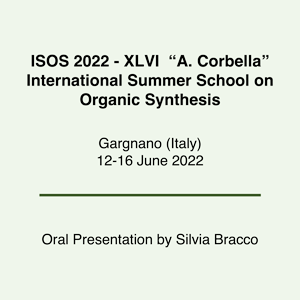Gargnano (Italy), 12-16 June 2022, Oral Presentation by Silvia Bracco
Title: “Dynamics and Gas Detection in Nanoporous Architectures by Solid State NMR”
Authors: S. Bracco, J. Perego, C. X. Bezuidenhout, S. Piva, A. Comotti and P. Sozzani
Abstract
Nanoporous materials offer stimulating perspectives in building molecular rotors in the solid state and exploring sorptive properties and gas transport. In this field a particularly prominent application of solid state NMR is the study of dynamic processes in solids and in the gas phase. Molecular rotors in the solid state find a favourable playground in porous materials, such as MOFs, thanks to their large free volume, which allows for fast dynamics. In particular, we have realized a ultra-fast molecular rotor in the solid state, whose rotation speed approaches that of unhindered rotations in organic moieties even at very low temperatures.1 The rotor based on bicyclo[1.1.1]pentane–dicarboxylate moiety was installed in the 3D cubic structure of a highly porous zinc MOF, thus isolating the individual rotor from each another (Fig. 1a, b). Solid state NMR relaxation measurements 1H T1 and muon-spin spectroscopy 2 performed at temperatures as low as 2 K allowed the determination of an activation energy as low as 6.2 cal mol-1, consistent with fast molecular reorientation in the GHz regime even at the lowest temperatures (Fig. 1c). Self-assembly of polyfunctional molecules containing multiple charges, namely, tetrahedral tetra-sulfonate anions (TBS) and bi-functional linear cations (DAB), resulted in a permanently porous crystalline material in which the channels are decorated by double helices of electrostatic charges that governed the association and transport of CO2 molecules (Fig. 2 a-c). The ionic patterning of the channels allows the establishment of high interactions of 35 kJ mol-1, ideal for CO2 capture/release cycles.3 The remarkable CO2-matrix association allowed direct observation of the gas exploring the nanochannels by 13C CP-MAS NMR spectroscopy and the identification of the specific interaction sites by 2D 1H-13C HETCOR MAS NMR experiments (Fig. 2d). References 1. J. Perego, S. Bracco, M. Negroni, C. X. Bezuidenhout, G. Prando, P. Carretta, A. Comotti, and P. Sozzani, Nat. Chem. 2020, 12, 845. 2. G. Prando, J. Perego, M. Negroni, M. Riccò, S. Bracco, A. Comotti, P. Sozzani, P. Carretta, Nano Lett. 2020, 20, 7613. 3. G. Xing, I. Bassanetti, S. Bracco, M. Negroni, C. Bezuidenhout, T. Ben, P. Sozzani, A. Comotti, Chemical Science 2019, 10, 730.

